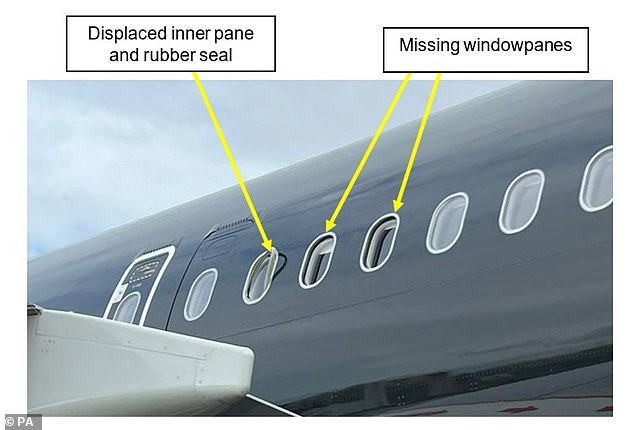Charter flight from London to Orlando reached 14,000 feet before it was forced to land after crew realized two WINDOW PANES were missing
- The Titan Airways plane took off from London’s Stansted Airport on October 4
- It carried 11 crew members and nine passengers
- During a film shoot, the windows were damaged by powerful lights
A charter flight flying from London to Orlando was forced to land after the crew realized it had reached an altitude of 4,000 meters and two windows were missing.
The Titan Airways plane, previously used by King Charles and British Prime Minister Rishi Sunak, took off from London’s Stansted Airport on October 4 before the crew realized the windows had been damaged during a film shoot the day before.
The Airbus A321 was carrying 11 crew members (three pilots, an engineer, a loadmaster and six cabin crew) and nine passengers who are also employed by the airline and US-based luxury travel company TCS World Travel.
Shortly after takeoff, passengers noticed the cabin was colder and noisier than normal, according to a report by the Air Accidents Investigation Branch.
The plane continued to climb and reached an altitude of 10,000 feet, which meant the seat belt signs were off.
The Titan Airways plane took off from London’s Stansted Airport on October 4 before the crew realized the windows had been damaged during a film shoot the day before

Shortly after takeoff, passengers noticed that the cabin was colder and noisier than normal
At that point, the loadmaster moved to the rear of the aircraft and noticed that it was “loud enough to damage your hearing.”
Then he noticed a window seal on a window that was “flapping in the airflow.”
At that point – at 4,000 meters altitude – the crew decided to stop the plane’s climb and reduce its speed.
An engineer and pilot then looked at the windows and agreed that the aircraft should return to Stansted.
The plane landed back in London 36 minutes after take-off.
Once the plane was parked, the crew inspected the windows and realized that two of them were missing parts, the inner and outer panels and the rubber seal.
The inner pane and seal were also missing from a third window.
During a film shoot, the windows were damaged by powerful lights.
The AAIB said: ‘While in this case damage at around FL100 became apparent and the flight was terminated without incident, a different level of damage using the same means could have led to more serious consequences.’
